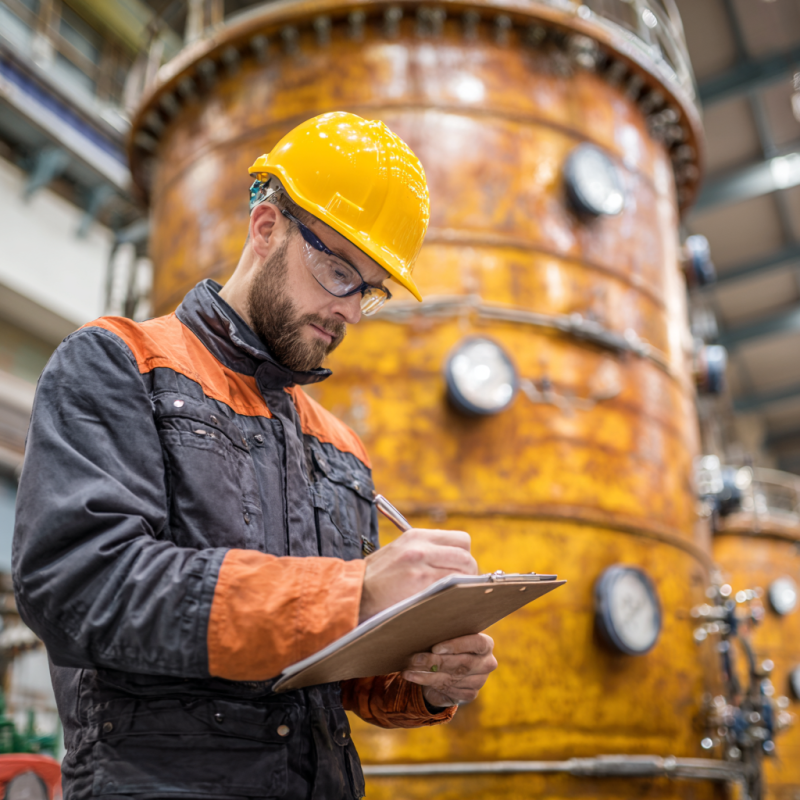
What Is Pressure Vessel Safety? Key Considerations
What is Pressure Vessel Safety and Why It’s Critical
Pressure vessel safety is a crucial aspect of maintaining the integrity and functionality of pressurized equipment. With high risks associated with the operation of pressure vessels, understanding what is pressure vessel safety and taking the necessary precautions can prevent potential accidents, reduce downtime, and extend the life of these critical industrial assets.
Pressure vessels are containers designed to hold gases or liquids at a pressure substantially different from the ambient pressure. They are commonly used in industries such as oil and gas, power generation, and chemical manufacturing. Ensuring their safety requires a robust framework of design, inspection, and operational guidelines. This blog will explore the various safety measures, standards, and practices that help mitigate risks and enhance the safe operation of pressure vessels. Learn more about our pressure vessels here.
Effective Pressure Vessel Safety Measures
Quality Control in Manufacturing
The first step in ensuring pressure vessel safety is ensuring that the vessel is properly manufactured. Adhering to strict quality standards during fabrication prevents the occurrence of defects that could lead to catastrophic failures. Manufacturers need to ensure that the materials used meet safety requirements, and the designs comply with industry regulations. Learn more about the quality testing and inspection of pressure vessels.
Training for Personnel Handling Pressure Vessels
Proper training for personnel is crucial to pressure vessel safety. Employees must be trained on the handling, operation, and inspection of these vessels to minimize human error and increase the effectiveness of safety measures. Ensuring that all personnel understand safety protocols can significantly reduce accidents. Read more about our training services here.
Operational Safety Measures
Proper operational procedures are necessary to ensure that pressure vessels are used within their designed pressure limits. Regular monitoring of vessel conditions, controlling pressures, and implementing fail-safes will minimize the risk of equipment failure. Explore our solutions for operational safety.
Periodic Audits and Inspections
Regular audits and inspections are an essential part of pressure vessel safety. Pressure vessels must undergo thorough inspections at defined intervals to ensure they are operating within safety limits. Inspections include visual checks, pressure testing, and non-destructive testing methods such as ultrasonic or radiographic tests. These inspections detect potential defects or damage before they lead to a failure. Read more about our inspection and testing services.
Pressure Relief Devices
Pressure relief devices are critical to maintaining safety within pressure vessels. These devices prevent overpressure situations, which can cause catastrophic failure. They release excess pressure, ensuring that the vessel operates within safe limits. Regular maintenance and testing of these devices are necessary to ensure their effectiveness. Find out more about pressure relief devices.
What are Pressure Vessels?
Pressure vessels are containers designed to hold substances under pressure, either in gas or liquid form. Common applications of pressure vessels include storage tanks, heat exchangers, and boilers. Due to their nature, pressure vessels must be designed, constructed, and maintained in compliance with strict safety standards. Learn more about our pressure vessel design process.
What are the Different Pressure Vessel Standards?
Pressure vessels must meet specific industry standards to ensure their safety. These standards are set by organizations such as the American Society of Mechanical Engineers (ASME) and the National Board of Boiler and Pressure Vessel Inspectors (NBBI). Below are three key standards for pressure vessels.
Division I
Division I pertains to the design, materials, and construction methods for pressure vessels. It focuses on ensuring that vessels are designed to withstand operational pressures safely. Explore ASME-certified pressure vessels.
Division II
Division II is more stringent and applies to vessels that require higher safety factors due to their application or location. These vessels are designed with enhanced materials and stress limits. Learn more about pressure vessel certifications.
Division III
Division III covers pressure vessels designed for very high pressures, including those used in cryogenic and nuclear applications. The standards ensure that these vessels are capable of withstanding extreme operating conditions. Read more about our high-pressure vessel solutions.
Types of Pressure Vessels According to Their Purpose
Storage Vessels
These vessels are used to store liquids or gases under pressure. They are commonly found in industries like oil and gas. Learn more about storage vessels here.
Heat Exchangers
Heat exchangers transfer heat between two or more fluids and are often used in power plants, chemical plants, and refrigeration systems. These vessels must be designed to withstand high pressure and temperature. Explore our solutions for heat exchanger vessels.
Boilers
Boilers are used to generate steam by heating water under pressure. They are widely used in energy production, and their design must meet strict safety standards to avoid explosions. Learn about our boiler solutions here.
Process Vessels
These vessels are used in industrial processes such as chemical reactions, distillation, and filtration. They are designed to contain substances under pressure and must meet safety regulations to prevent accidents. Explore our process vessel solutions.
Types of Pressure Vessels According to Their Geometry
Spherical Pressure Vessels
These are the most efficient type of pressure vessel as their spherical shape allows them to withstand high internal pressures evenly. Explore spherical vessels here.
Cylindrical Pressure Vessels
Cylindrical vessels are the most common type used in the industry. They are easier to fabricate and maintain but must be designed with reinforcement to handle the pressure effectively. Learn more about cylindrical pressure vessels.
Pressure Vessel Safety Standards
Understanding and complying with pressure vessel safety standards is essential for minimizing risks. These standards ensure that the design, construction, operation, and maintenance of pressure vessels meet specific safety requirements. Learn more about pressure vessel standards.
What are the Criteria for Materials Selection for Pressure Vessels?
The selection of materials for pressure vessels is critical to ensuring safety and performance. The material must withstand the internal pressure and external environment to prevent failure. Common materials used include carbon steel, stainless steel, and alloy steels. Explore material selection in pressure vessel design.
What are the Commonly Used Materials for Pressure Vessels?
Pressure vessels are commonly made from various materials, each suited to different applications. Common materials include:
- Carbon Steel
- Stainless Steel
- Alloy Steel
- Nickel Alloys
- Titanium
Each material is selected based on the type of fluid or gas, operating pressure, and external conditions. Learn more about the materials used in our vessels.
Pressure Vessel Inspections and Testing
Regular inspection and testing of pressure vessels are necessary to ensure they operate safely. Testing methods include visual inspection, ultrasonic testing, and pressure testing. Find out about our inspection services here.
Manage Pressure Vessels Safely with a Digital Solution
Incorporating digital solutions for the monitoring and management of pressure vessels can enhance safety. Digital systems can track pressure, temperature, and condition in real-time, allowing for predictive maintenance and quicker response times to potential issues. Learn more about our digital solutions.
What is pressure vessel safety
What is pressure vessel safety is not only about ensuring compliance with regulations but also about protecting lives, equipment, and the environment. Adopting stringent safety measures, conducting regular inspections, and adhering to industry standards are all critical for safe and efficient operation. Proper training, material selection, and testing protocols can go a long way in preventing accidents and extending the lifespan of pressure vessels.
At Red River, we are committed to the design, manufacture, and inspection of top-quality pressure vessels that meet all necessary safety standards. Explore our pressure vessel services.
Need a reliable partner?
Red River specializes in the design and manufacturing of pressure vessels. We also fabricate related items such as prefabricated spools and skid packages.
Reach out to us today and experience the Red River difference. Where American-made products and American Values come together, we care more.
Frequently Asked Questions
1. What are Pressure Vessel Inspections?
Pressure vessel inspections verify safety and integrity through initial, periodic, internal, and external checks using visual, non-destructive, and pressure testing. Certified inspectors follow strict codes to ensure compliance.
2. What are Pressure Vessel Safety Standards?
Pressure vessel safety standards set minimum requirements for design, testing, and operation to prevent accidents. Key codes include ASME BPVC, EN 13445, and CSA B51.
3. How Big Should a Pressure Vessel Be?
The size of a pressure vessel is determined by the volume of fluid or gas it needs to hold, the operating pressure, and safety factors.
4. Is There a Difference Between a Pressure Vessel and a Storage Tank?
Yes, a pressure vessel is designed to handle high internal pressures, whereas storage tanks are generally not built to withstand such pressures. Learn more about pressure vessel safety standards.
5. What Materials Are Used to Make Pressure Vessels?
Common materials include carbon steel, stainless steel, and composite materials. The choice depends on the application, operating pressure, temperature, and the type of fluid or gas being stored.
6. What Are the Common Applications of Pressure Vessels?
Pressure vessels are widely used in industries such as oil and gas, chemical processing, power generation, and food processing, where they store gases or liquids under pressure safely.
Key Takeaways
- Pressure vessel safety is essential to prevent accidents and ensure the longevity of equipment.
- Regular inspections and maintenance help identify potential issues early.
- Material selection plays a crucial role in ensuring the vessel’s structural integrity.
- Safety protocols should be followed to minimize human error and avoid equipment failure.
Related Blog Post
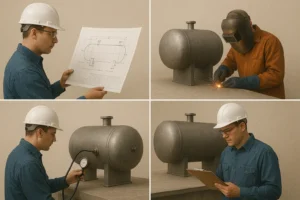
Pressure Vessel Design & Engineering: Concept to Launch
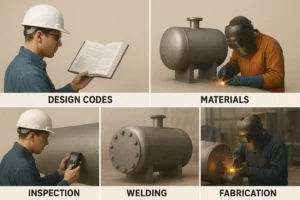
What is Pressure Vessel Design and Engineering: Code-Ready Guide
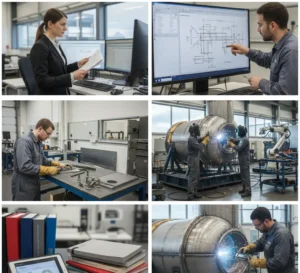
What are the Key Factors in Pressure Vessel Engineering
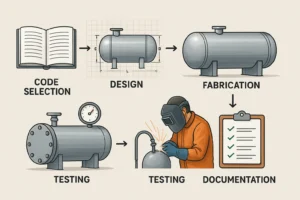
How Do You Design a Pressure Vessel: A Step-By-Step Guide
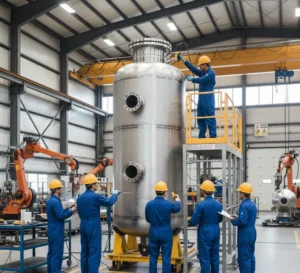
What is Pressure Vessel Fabrication and Manufacturing
About Author

